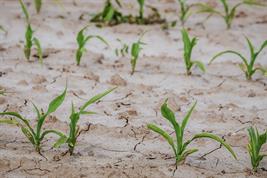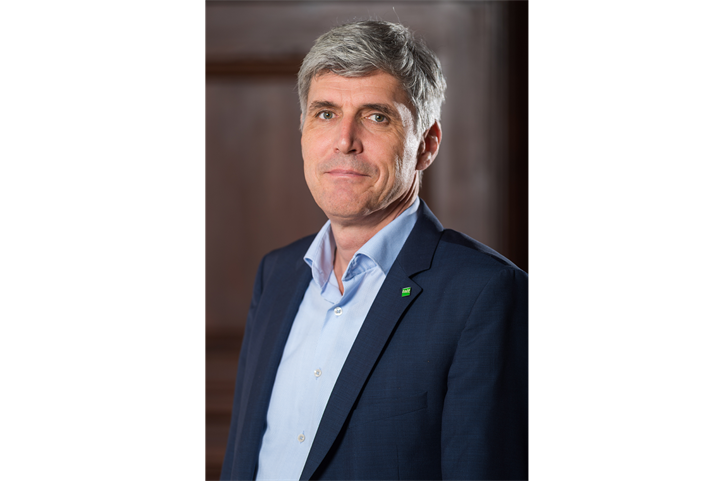09.08.2019
PRESS RELEASE

Prof. Frank A. Ewert is the Director of the Leibniz Centre for Agricultural Landscape Research (ZALF) in Müncheberg, Brandenburg and Professor of Crop Science at the University of Bonn. In this interview he answers questions on the current situation of agriculture and calls for an intensified public discourse on what a sustainable and climate-resilient agriculture of the future should look like.
Prof. Ewert, we are seeing more and more problems in the fields: extreme weather events such as heat, drought, hail and floods, strongly fluctuating yields, nitrate limits being exceeded and much more. The Intergovernmental Panel on Climate Change is currently calling for urgent changes in its Special Report on “Climate Change and Land”. What is the situation with regard to agriculture in Germany and how quickly are these changes possible?
The challenges farmers are facing today are extremely complex and diverse. The social pressure to act is increasing. But the agricultural sector has not been inactive in the last decades. Stricter national and European requirements have had to be complied with as well as global market fluctuations. However, the pressure has not been as intense as it is today. Society wants food at reasonable prices. At the same time, its ecological footprint, i.e. negative environmental and climate impacts, should be reduced, for example through a reduced use of fertilizers and pesticides as well as lower greenhouse gas emissions. We also want to maintain and develop ecosystem services and biodiversity that our agricultural landscapes provide for society: these include insect pollination, clean air and water, attractiveness for tourists, recreational effects etc. Without the right framework conditions in politics and in civil society, without a new way of rewarding such important services, farms cannot overcome these challenges. And even given the right conditions, it would not be possible to achieve all our goals immediately. We must have a public discourse on what we want to do and in what order, how we want to go about it, and what we are prepared to give up if necessary. The debate about less meat in our diet or the reduction of food waste and losses, as called for in the current IPCC Special Report “Climate Change and Land”, are good examples of this. It is therefore of central importance that we as researchers work together with politicians and interest groups on a common strategy and conduct an objective discussion that also includes consumers.
What strategy can we use to resolve the problems?
Policy makers are already very active: there are individual strategies, but there is no overarching strategic umbrella that integrates the individual aspects, identifies solutions for conflicting goals and creates synergies. I am talking about an idea that is shared by society as a whole of where we want to take agriculture in Germany, what it can and what it should be capable of and what it should not. Let me give you a few examples: Various strategies and measures are being developed, such as an arable farming strategy and a grassland strategy. The Federal Government's climate cabinet is currently working on draft legislation and an action plan and there are efforts for an agenda to adapt agriculture and forestry as well as fisheries and aquaculture to climate change. We have a bio-economic strategy that is currently being revised. There are conceptual considerations on spatial unbundling and a position on the so-called “green architecture” within the framework of the EU’s Common Agricultural Policy. A forest strategy is being prepared as well. My question at this point is whether these very sensible approaches can be integrated and how we can take this one step further into the field of nutrition. The main task of agriculture, I think, remains clear: It has to feed a growing world population and is not an end in itself.
What could that look like in concrete terms?
The EAT-Lancet Commission, an international body of 30 world-leading scientists in their fields, has made the relationship between agricultural production and the food system clear. It has demonstrated what our diets should look like in the future in order to be able to produce sustainably. The current IPCC Special Report “Climate Change and Land” supports these recommendations and explains how there cannot be climate protection in agriculture without changes in our dietary habits. The advantage of this approach is obvious: Agriculture cannot be thought of only in terms of production, the consumer side is an important side of the same coin and this connection must also be reflected in an overarching strategy.
Does this mean that individual strategies are useless?
No, individual strategies are valuable if they bundle specific expertise in sub-areas. Ultimately, however, it must also be possible to implement these ideas. When dealing with a highly complex topic such as agriculture, a strategic umbrella is needed under which these individual strategies can converge in order to resolve conflicting objectives and create synergies. What's more: Agriculture does not stop at national borders. A national arable farming strategy is undoubtedly important. However, it will only gain adequate support if it actively takes the European and the international perspective into account. The Climate Cabinet of the Federal Government, but also the European Union, must now react with the further development of a Common Agricultural Policy and focus more closely on effective climate protection and adaptation in agriculture while at the same time ensuring nature conservation, animal welfare and environmental protection as well as food security.
Can you give us examples of how the national and international perspectives come together?
One very tangible example are German products from animal husbandry, such as milk and meat. We produce these locally using a significant amount of resources, partly using imported animal feed and thus with a high environmental impact. Consider the ongoing debate about nitrate levels. At the end of the day, these are simply the result of intensive, regionally concentrated animal husbandry. We also export a large proportion of these products to China – and that is good business. As a result, certain rural regions in Germany are doing very well, which is a good thing. However, we have high nitrogen surpluses and nitrate pollution as a result of intensive animal husbandry in these regions. And so, the question of intensive animal husbandry with a high environmental impact and international shipping is also a question of regional rural development. We are therefore always talking about conflicting objectives when it comes to the complex issue of agriculture. Identifying such conflicting objectives in a regional, national, European and international context would be a central objective of an agricultural strategy.
What role do farmers play in this?
Farms today are faced with a whole catalog of requirements that they cannot possibly meet on their own. Just to give you a few examples: In the last three years we have had one excessively humid summer, followed by two excessively dry summers with extreme weather conditions that are increasingly depleting the soil and, in some regions, leading to considerable crop and income losses. And I have not yet even mentioned society's demand for stronger protection of animals and the environment as well as for more biodiversity. Without further assistance from policymakers and without a change in society's mindset, these demands will lead to farmers being structurally overburdened – more and more will close down their businesses. The social recognition of agriculture is a very important factor here as well.
So consumers also have to think about their role in this?
Absolutely! If we look at the soils that are too dry, we have to consider whether we can cultivate other crop cultivars, develop new value chains and open up new markets and new business models for agriculture – millet and legumes are good examples here. But for that to happen, there must also be a market, that is to say a demand from consumers. It should not be forgotten that industry has to set up the appropriate processing chains in order to bring the yields from the field to the consumer's table. Why should farmers with their comprehensive knowledge of new business models not be rewarded more handsomely in future for providing the ecosystem services desired by society and for safeguarding biodiversity? It is also important that we do not point the finger at “the” agriculture, but rather that we shape the future together through objective dialog.
The introduction and in particular the implementation of these new agricultural systems and business models will not be easy. It also involves the transformation and restructuring of entire agricultural landscapes. An agricultural strategy must therefore also describe these transformation processes, a concrete path to an agriculture of the future, in realistic individual stages. Digitization and new, developing technologies such as robotics, sensor technology and big data are important building blocks of this transformation and of future agricultural systems.
So as you can see, agriculture is a highly complex process. But with nutrition being one of the essential needs of a society, we need to work together on this. Developing a comprehensive agricultural strategy that combines the socially acceptable provision of healthy food with climate protection, animal welfare, nature conservation and environmental protection is an urgent step in this direction. In this strategy we need to define specific goals, integrate digitization and new technologies and develop specific, practical transformation paths towards the agriculture of the future.
 Press Release as PDF
Press Release as PDF
Picures
For downloading the pictures please click on a picture and use the icon.


Prof. Dr. Frank A. Ewert, Scientific Director of the Leibniz Centre for Agricultural Landscape Research (ZALF) and Professor of Crop Sciences at the University of Bonn. The image is released for editorial reporting purposes provided the source of the image is given: © Andreas Krone / ZALF.
